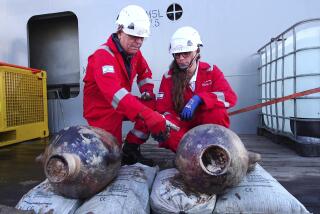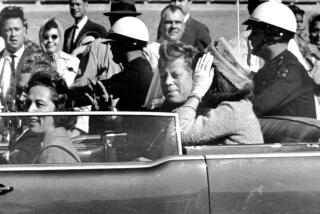Shipwreck Hunter Says JFK’s WWII Boat Found
SYDNEY, Australia — Shipwreck hunter Robert Ballard said Wednesday that he has found the World War II patrol boat commanded by John F. Kennedy in the Pacific Ocean off the Solomon Islands.
The remains of the wooden boat, PT-109, were lying on the seabed in the Blanket Strait near Gizo in the New Georgia group of islands, Ballard told Solomon Islands Broadcasting Corp. radio.
Gizo is 235 miles northwest of Honiara, the Solomons’ capital.
“What they have found is a couple of torpedo tubes,” a source in Gizo told the Reuters news agency.
“They were looking for three engines in a row or anything like that. But the torpedo tubes, that’s reasonably significant.... There were no other PT boats lost in that vicinity and there wouldn’t be any other torpedo tubes like that anywhere else in the region from any other vessel,” he said.
Ballard, who led a team that found the Titanic shipwreck in 1985, said he located the wreckage of Kennedy’s boat last week after searching for about a week. He did not provide further details of the discovery, citing contractual obligations on film and magazine rights to the search.
The radio report said a National Geographic documentary will be released in November. National Geographic issued a statement saying that its expedition to the Solomon Islands to search for the remains of PT-109 had concluded and that Ballard was making his way home.
The PT-109 sank in August 1943 after it was hit by a Japanese warship.
It is unknown how much of the boat remains besides the engines. Water is expected to have caused extensive damage to the hull.
Ballard had planned to use remote cameras in the search.
The late president’s daughter, Caroline, and his brother, Sen. Edward M. Kennedy (D-Mass.), agreed to the expedition after being assured that the site would not be disturbed. Two members of Kennedy’s crew died when the boat was hit.
In a 1999 interview, Ballard said the PT-109 is “not lost, just misplaced.” But he added that searching for the vessel in an area full of unexploded ordnance would be “no fun.”
Kennedy was commanding a patrol Aug. 2, 1943, when the boat was hit and cut in two by a Japanese destroyer.
Kennedy and 10 other survivors swam 15 hours to reach a nearby island. He towed one injured survivor, engineer Patrick Henry McMahon, by swimming with a strap from McMahon’s lifejacket in his teeth.
They later swam to another island where there were coconuts to eat. Kennedy carved a message into one coconut and gave it to a native to take to rescuers.
Patrol torpedo boats, such as the PT-109, had mahogany hulls. Plywood was used for the internal structures, chart houses and gun turrets. They were 80 feet long and powered by 12-cylinder gasoline engines.
More to Read
Sign up for Essential California
The most important California stories and recommendations in your inbox every morning.
You may occasionally receive promotional content from the Los Angeles Times.










